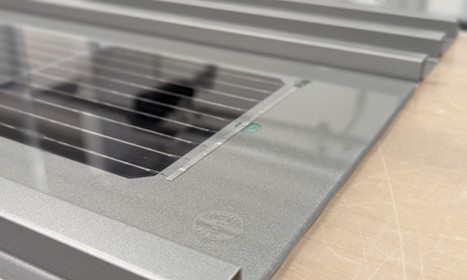
Building-integrated photovoltaics makes it possible to generate electricity directly where it is needed. To do this, solar modules are integrated into the structure of buildings. At the Fraunhofer Center for Silicon Photovoltaics CSP, a new project is researching production processes for connecting photovoltaic modules with aluminum components so that efficient energy generation, architectural freedom of design and cost-effective manufacturing processes are combined. Initial results will be presented at the EU PVSEC from September 23 to 27 in Vienna.
By 2030, 65 percent of electricity consumption in Germany is to be covered by renewable energy sources. Photovoltaics (PV) will play an important role in this, and this will increasingly also apply to solar modules that are directly integrated into the facade surfaces of buildings. This opens up further areas for the generation of sustainable electrical energy, and the spatial proximity between consumer and producer is also a major advantage. In the meantime, a wide range of design options are also possible, with aesthetically pleasing solutions.
This is the starting point for the “AluPV” project, which is scheduled to run until the end of 2025 and in which the Fraunhofer CSP, MN Metall GmbH, VHF Plan Liesenhoff, Baltic Renewable Partners GmbH & Co. KG, Solarnative GmbH and the Institute for Solar Energy Research GmbH are working together. The research partners are developing new manufacturing processes and material combinations by combining metal construction for facades and the possibilities of the photovoltaic industry. “We want to implement a novel composite of aluminum facades and PV modules. The focus is also on the further development of lightweight profiles to minimize the overall weight. However, instead of laboriously concealing the solar cells, we are developing an innovative modular facade system that allows new degrees of freedom in the design of PV-activated facades,” says Ringo Koepge, a member of the ‘PV Modules, Components and Manufacturing’ group at the Fraunhofer CSP.
Key issues include, for example, the adhesion of module backsheets to aluminum surfaces, the possibilities for laminating solar cell strings, the avoidance of glass breakage and the stretching/bending of the metal facade, as well as ensuring functionality. The electrical concept and the mechanical suspension for quick and easy installation and the easy replacement of building-integrated photovoltaic modules, as well as their ecological and economical combination of materials, are also the focus of the investigations.
The current research work focuses on the processing of different material types such as glass, polymers and aluminum. The combination of materials with large differences in thermal expansion plays a decisive role both for defect-free production and for later application on the facade. Both institutes want to provide solutions for subsequent industrial implementation. To this end, the Fraunhofer CSP and the Institute for Solar Energy Research GmbH will present initial results regarding process control and characterization at this year's EU PVSEC from September 23 to 27 in Vienna.
In the further course of the project, the team at the Fraunhofer CSP provides support for all technological and material-related issues in the project, in material processing, module design and the evaluation of processing variants. Thanks to the expertise and possibilities for photovoltaic production available at the institute, variants and material structures of different module technologies can be developed and compared with the production technology requirements for the production of aluminum facade elements. Reliability analyses ensure that safety requirements are met and that the necessary certificates can be issued. At the same time, new methodological approaches are to be developed specifically in the context of photovoltaic building integration. These form the basis for further improved quality assurance analyses of materials used in building-integrated PV.
(September 23, 2024)
 Fraunhofer Center for Silicon Photovoltaics CSP
Fraunhofer Center for Silicon Photovoltaics CSP